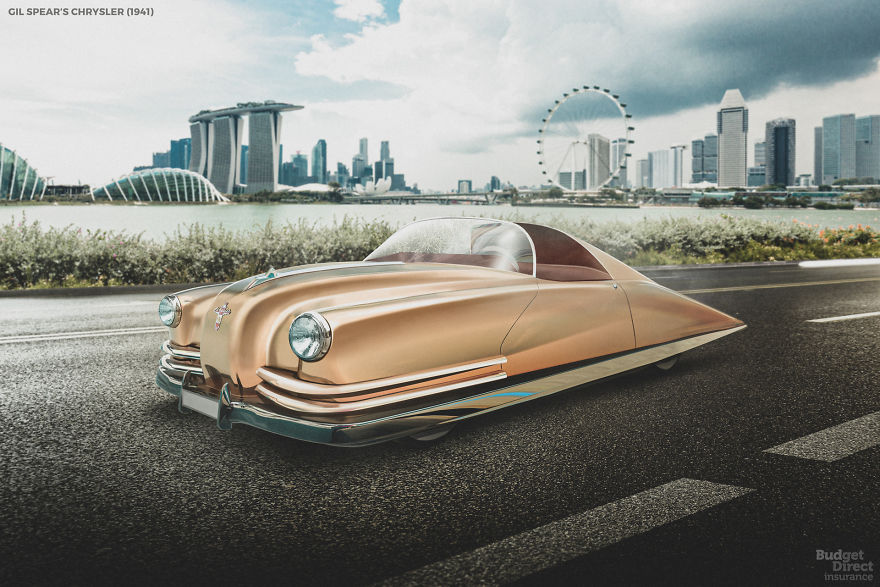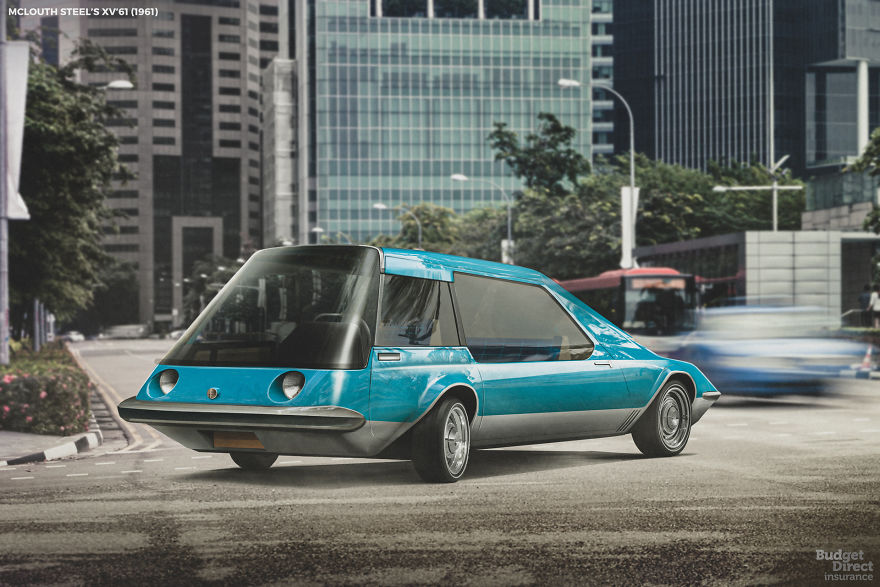
Designers Recreate 7 Futuristic Vehicle Designs From The 1900s That Never Happened
We have always been curious about how the future world would look and how modern technologies would develop, as there’s no way to predict it. This curiosity was especially aroused in the last century, when American futurists had many wild techno-utopian dreams about the future. Nothing was too far-fetched or too luxurious; however, when faced with reality, engineers realized their limits. Budget Direct brought to life seven speculative blueprints of the past, reimagining how they would look in today’s world in a series of digital renders.
“This project is basically us nerding out. It’s a combination of two things we’re huge fans of: the art featured in old copies of Popular Mechanics, Popular Science, and Modern Mechanix; and the designs of Syd Mead. Syd Mead is the greatest concept vehicle designer ever. He pretty much single-handedly defined the ‘futuristic’ aesthetic that you see in sci-fi films and shows like Star Wars and Star Trek. (He also actually designed vehicles and sets in Blade Runner, Short Circuit, and Tomorrowland.) So of course, any excuse we have to create realistic renders of his work, we jump at.
Popular Mechanics, Popular Science, and Modern Mechanix are three (very similar) magazines that have from the 1930s given people a window into the future… or at least a dream of the future. Every issue is packed full of crazy concept vehicles and wacky inventions. They’re a joy to read.
When it came to choosing the designs, it was a long process. Not because it was difficult to find retro vehicle concepts, but because we all have our favorites and so there was a lot of ‘discussion.’ The final choices were the vehicles we felt best captured a specific style or aesthetic, whether that was Walter Molino’s comical singlet or Syd Mead’s slick and stylish anti-grav car,” NeoMam Studio production team leader Jonny Addy told Bored Panda.
More info: budgetdirect.com.sg
Super-Cycle (1936)
Image credits: Budget Direct Singapore
“The June 1936 cover of Modern Mechanix & Inventions Magazine promised two revolutionary technologies: television, and the 300mph Super-Cycle. Sadly, the Super-Cycle and its unnamed inventor were quickly left behind by TV.
The Super-Cycle is capable of reaching record-breaking speeds on its spherical wheels. The driver is safely encased within the bike’s aerodynamic shell. For added safety, there is a cushion attached to the front of the canopy windshield to lean your head on as you power forward. And those twin motors? ‘Two separate power plants are employed, one on each side of the powerful rigid chassis,’ explains the author, without even blushing.”
Chrysler “Heir” (1941)
Image credits: Budget Direct Singapore
“Gil Spear started as a specialist within the trade of car design: he mostly did the fronts. The 1939 Plymouth, 1939 New Yorker, and 1940 Saratoga front ends were his. And Chrysler adopted the wraparound grille on this unbuilt 1941 cruiser for their 1942 Royal (hence we’ve christened the ’41 model the ‘Chrysler Heir’).
Spear’s proto-space-age Chrysler tapers to a point at the rear, encasing a maximum of two passengers in the bubble-like cockpit. We can imagine that the designer would have projected the speedometer onto the windscreen, since that was one of his proposals for Ford a few years later.”
HobbyPop RoadShop (1958)
Image credits: Budget Direct Singapore
“Nostalgic for woodwork, cheerful Partridge Family optimism, and casual sexism? You’ll love this 1958 bus-length workshop on wheels. The elevated driver’s cabin means Mum is far less likely to take a wrong turn. Plus, the entire lower deck is left free for Dad to use it as his carpentry workshop.
Okay, so Bruce McCall actually drew up the HobbyPop RoadShop in 2001 to parody vehicles like the others on our list. But it’s still an oddly plausible addition to the world of the 20th-century speculative vehicle design.”
McLouth – XV’61 Concept (1961)
Image credits: Budget Direct Singapore
“Syd Mead’s most famous vehicles are the TRON Light Cycle (which inspired Kaneda’s bike in Akira) and Blade Runner’s flying Spinner car. Mead’s military-funded design for ‘a four-legged, gyro-balanced, walking cargo vehicle’ directly inspired the Star Wars AT-AT. But if you’re more of a Volvo sort of person, consider the XV’61, which Mead designed for—um—the McLouth Steel Corporation.
McLouth built the XV (‘Xperimental Vehicle’) for the ’61 New York International Automobile Show, boasting that the family car was both road-safe and future safe—because it would also run on the monorail. Minimal trim and simple geometric lines just about keep the XV’61 down-to-Earth for the responsible family man with one eye on the future.”
Singlets (1962)
Image credits: Budget Direct Singapore
“Suddenly, the Singoletta doesn’t seem far-fetched. Put a canopy on a Segway and you have the perfect social-distancing little vehicle. ‘A speed of no more than forty kilometers per hour. A minimum of protection from the weather. A minimum of space. A minimum of consumption. A minimum of cost.’
The (‘Extraordinary’) magazine artist Walter Molino illustrated the Singoletta for the Domenica del Corriere in 1962. But the actual inventor was the mysterious Cesare Armano, a pseudonym for the famous correspondent and science-fiction author Franco Bandini. Bandini’s solution to the traffic pandemic would cost a quarter of the price of a Fiat 500, and ten ‘Singlets’ would fit in the space of one car. Plus, its electric motor would have been kind to the environment. Visionary!”
The New Urban Car (1970)
Image credits: Budget Direct Singapore
“In 1970, the average 4-seater carried just 1.2 humans (today, it’s 1.67), clogging the air and roads. Automotive writer Ken W. Purdy imagined the solution in a Playboy article illustrated by Syd Mead. ‘Tomorrow’s in-city car’ would be a two-seater with a cheap, quiet, slightly greener gas turbine in place of the internal combustion engine.
Space is maximized by combining the steering wheel and accelerator into a single fold-away lever. Swing it to steer, twist it to accelerate. The rear unit–including wheels, turbine, and transmission–is detachable to make repairs easier. ‘A cheap but adequate two-way telephone’ comes as standard. Looking for the doors? The canopy simply flips open and is hinged at the bumper.”
Anti-Gravity Car (1979)
Image credits: Budget Direct Singapore
“Mead’s 1979 anti-gravity vehicle conjures worlds beyond us, being part Spinner and part TIE fighter with a hint of Batwing. ‘We don’t really know what gravity is but we’re going to figure it out,’ Syd Mead told Car Magazine, shortly before his death. ‘I think that’s the next huge breakthrough in controlling the real world.’
The Anti-Grav’s wraparound windscreen gives the driver-pilot a clear view in all directions. But wherever you’re going, you still need roads as this is a hovering vehicle rather than an all-out flying car. Note to city planners: Mead’s illustration includes buffer walls at street level to stop the car’s overhanging fins from knocking down pedestrians!”
12Kviews
Share on FacebookExplore more of these tags
Singlets wheels are so small the car would probably fall over when you hit a bump!!!
Or when a teenager walked by and tipped you over for fun.
Load More Replies...Me too, I'm going to get my cash but where can i get one?
Load More Replies...Singlets wheels are so small the car would probably fall over when you hit a bump!!!
Or when a teenager walked by and tipped you over for fun.
Load More Replies...Me too, I'm going to get my cash but where can i get one?
Load More Replies...
 Dark Mode
Dark Mode 

 No fees, cancel anytime
No fees, cancel anytime 

























































94
24